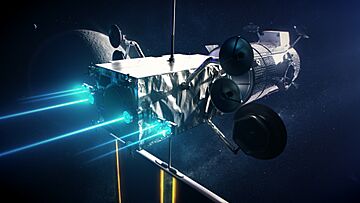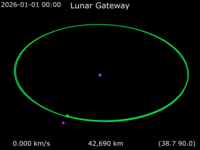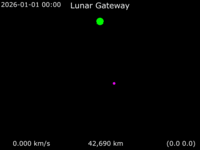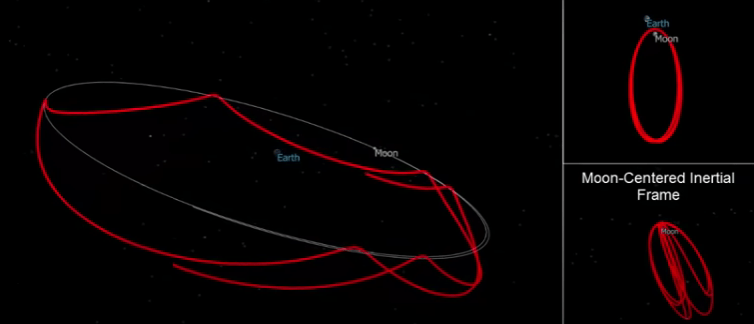Lunar Gateway facts for kids
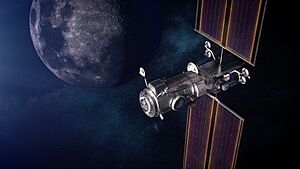
An illustration of the Gateway's Power and Propulsion Element (PPE) and Habitation and Logistics Outpost (HALO) in orbit around the Moon
|
|
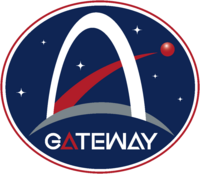 |
|
| Station statistics | |
|---|---|
| Crew | 4 maximum (planned) |
| Launch | 2027 (planned) |
| Carrier rocket | Falcon Heavy SLS Block 1B |
| Launch pad | Kennedy Space Center Launch Complex 39
|
| Mission status | In development |
| Pressurised volume | ≥125 m3 (4,400 cu ft) (planned) |
| Perigee | 3,000 km (1,900 mi) |
| Apogee | 70,000 km (43,000 mi) |
| Orbital inclination | Polar near-rectilinear halo orbit (NRHO) |
| Orbital period | ≈7 days |
| Configuration | |
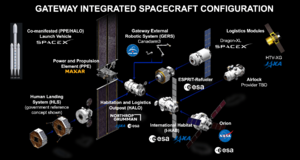
Configuration as of 16 November 2022
|
|
The Lunar Gateway, often just called Gateway, is a space station that will orbit the Moon. It's like a small space outpost for astronauts. The Gateway will be a communication hub, a science lab, and a living space. It's a key part of the Artemis program, which aims to send humans back to the Moon.
Many countries are working together on this project. These include NASA (USA), the European Space Agency (ESA), the Japan Aerospace Exploration Agency (JAXA), the Canadian Space Agency (CSA), and the Mohammed Bin Rashid Space Centre (MBRSC) from the UAE. The Gateway will be the first space station built far beyond low Earth orbit.
Scientists plan to study many things from the Gateway. This includes the Moon itself, distant stars and galaxies, and even our own Earth. They will also study the Sun's effects and how humans can live and work in deep space. As of April 2024, the first parts of the station are being built. Experts believe the Gateway is very important for future human missions to the Moon, Mars, and deeper into the Solar System.
The Gateway will play a big role in the Artemis program after 2024. NASA has set aside a lot of money for the project. While NASA leads the effort, it's a team project with its international and commercial partners. The station will be a starting point for both robotic and human missions to the lunar south pole. It's also planned as a stop for future trips to Mars.
Contents
What is the Gateway's Name?
The station was first called the Deep Space Gateway. Later, in 2018, NASA renamed it the Lunar Orbital Platform-Gateway. Finally, it became known simply as the Lunar Gateway or Gateway. In 2019, the US Congress approved money for early studies of the station.
In November 2019, NASA gave the station its current name and logo. The design was inspired by the St. Louis Gateway Arch, a famous American symbol.
How Did the Gateway Project Start?
Early Ideas for Lunar Stations
The Apollo Command and Service Module was the first spacecraft to orbit the Moon with a crew. It could connect with the Apollo lander. For a long time, the main focus for human presence on the Moon was building Lunar bases, like the first one, Tranquility Base.
NASA first talked about a station orbiting the Moon in 2012. It was called the Deep Space Habitat. This idea led to studies in 2015 about what a deep space living area would need. In 2018, these studies helped decide what features the Gateway's living modules should have.
International Cooperation
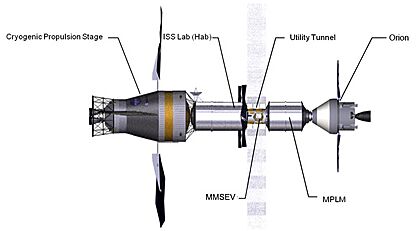
In 2017, NASA and Russia's Roscosmos talked about working together. However, in 2020, Roscosmos decided not to join. They felt the project was too focused on the U.S.
As of 2024, the Canadian Space Agency (CSA), the European Space Agency (ESA), Japan Aerospace Exploration Agency (JAXA), and Mohammed Bin Rashid Space Centre (MBRSC) are all part of the Gateway project. Each agency will add important parts. For example, Canada will provide a robotic arm called Canadarm3. Europe will add refueling and communication tools, plus living and research space. The UAE will provide an airlock module. These international parts will be launched after NASA's first modules are in orbit around the Moon.
Power and Propulsion System
In 2017, NASA asked companies to study ways to build the Power and Propulsion Element (PPE). This part of the Gateway will provide power and help move the station. Five companies received money for these studies. The PPE will use special Ion thrusters that get power from the Sun. It will also have chemical engines.
In 2019, Maxar Technologies won the contract to build the PPE. This module will give the station electricity. It will also have a communication system to talk with other spacecraft. The PPE is expected to work for about 15 years. In late 2023, tests were being done on the thrusters for this important module.
Where Will the Gateway Orbit?
The Gateway will orbit the Moon in a special path called a near-rectilinear halo orbit (NRHO). This orbit takes the station quite close to the Moon's north pole (about 1,500 km away) and then far away over the south pole (up to 70,000 km). It takes about 7 days for the Gateway to complete one orbit.
One great thing about this orbit is that it allows for almost constant communication with Earth. Traveling to and from this lunar orbit will help astronauts learn what they need for missions even deeper into space. This orbit also makes it easy for missions from the Gateway to reach the Moon's surface.
The Gateway will be the first modular space station that can be used by humans but also operate mostly on its own. This is because it will have very smart computer software to control all its systems. This station could also help test ways to use resources found on the Moon or asteroids. It will allow for a gradual build-up of abilities for more complex missions over time.
What Will the Gateway Look Like?
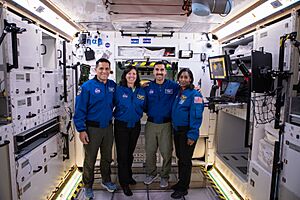
For the first crewed mission to the station (Artemis 4) in 2028, the Gateway will start small. It will have just two main parts: the Power and Propulsion Element (PPE) and the Habitation and Logistics Outpost (HALO). Both the PPE and HALO will be built on Earth. They will launch together on a Falcon Heavy rocket in 2027. It will take them about nine to ten months to reach lunar orbit.
The I-Hab module, built by ESA and JAXA, will launch later. It will travel with the Artemis 4 crewed Orion mission on the SLS Block 1B rocket. All the modules will connect using a standard docking system.
| Solar Array | PPE propulsion module |
Solar Array | |||||||||||||||||||||||||||||||||||
| Canadarm3 robotic arm |
ESPRIT-HLCS telecommunications |
||||||||||||||||||||||||||||||||||||
| HLS module docking port |
HALO logistics and habitat |
ESPRIT-ERM observation port and cargo storage |
GLS ship docking port |
||||||||||||||||||||||||||||||||||
| Fuel storage | |||||||||||||||||||||||||||||||||||||
| Heat radiator | Heat radiator | ||||||||||||||||||||||||||||||||||||
| DST vehicle docking port |
I-HAB logistics and habitat |
Utility docking port | |||||||||||||||||||||||||||||||||||
| Return shuttle docking port |
|||||||||||||||||||||||||||||||||||||
Planned Modules
- The Power and Propulsion Element (PPE) is being built by Maxar Technologies. It will provide electricity to the station using solar power. It will also help move the Gateway and other visiting spacecraft. The PPE will act as the main command and communication center for the station. It will weigh about 5,000 kg (half of that is fuel).
- The Habitation and Logistics Outpost (HALO) is being built by Northrop Grumman Innovation Systems. It will launch with the PPE module in 2027. HALO is based on the Cygnus cargo spacecraft. It will be a small living area for astronauts. It will have power, temperature control, communication systems, and docking ports. It can support a crew of four for at least 30 days. In April 2024, the main structure of the module was finished.
-
The European System Providing Refueling, Infrastructure and Telecommunications (ESPRIT) module is from ESA. It will add more fuel storage and communication equipment. It will also have an airlock for science experiments. This module will be built by Thales Alenia Space. It has two parts:
- Lunar Link will provide communications for the Gateway. It will launch in 2027 with the HALO module.
- Lunar View will hold fuel tanks, docking ports, and a small living area with windows. It will launch in 2029.
- The Lunar I-HAB is another living module. It's being built by ESA with help from Japan. Thales Alenia Space is building this module. It will include parts from other partners, like a life support system from JAXA and robotics from the Canadian Space Agency (CSA). This module is set to launch in 2028 with the Artemis 4 mission. It will travel with the crewed Orion spacecraft.
- The Canadarm3 is a pair of robotic arms. One is large, and one is small. They are similar to the famous Canadarm on the Space Shuttle and the Canadarm2 on the International Space Station. These arms can work on their own or be controlled by astronauts or ground teams. The Canadian Space Agency (CSA) is providing Canadarm3. MDA is building the arms.
- The Crew and Science Airlock Module will be used for spacewalks outside the station. It will also have a docking port for the proposed Deep Space Transport vehicle. This module will be built by the Mohammed bin Rashid Space Centre (MBRSC) from the UAE. It is planned to launch around 2030.
Future Modules
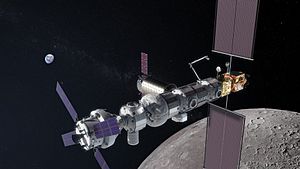
The Gateway is still growing, and more modules are planned for the future:
- These modules will bring fuel, supplies, and other important items to the station. The first logistics module will also bring a robotic arm from the Canadian Space Agency (CSA).
How Will the Gateway Be Built?
Astronauts will travel to the Gateway using the Orion spacecraft and the SLS rocket. Other supplies and robotic missions will use commercial rockets. In 2020, NASA chose SpaceX and its Dragon XL spacecraft to deliver supplies to the Gateway.
Phase 1 Construction Plan
The first two modules, PPE and HALO, will launch together on a Falcon Heavy rocket in 2027.
| Year | What's Happening | Mission Name | Rocket | Who's Going? | Status |
|---|---|---|---|---|---|
| 2027 | Launch of the Power and Propulsion Element (PPE) and Habitation and Logistics Outpost (HALO) | Falcon Heavy | Robotic | Under development | |
| September 2028 | Delivery of Orion spacecraft and I-HAB module | Artemis 4 | SLS Block 1B | Crewed | Under development |
| March 2030 | Delivery of Orion spacecraft and ESPRIT Refueling Module (ERM) | Artemis 5 | SLS Block 1B | Crewed | Under development |
| March 2031 | Delivery of Orion spacecraft and Crew and Science Airlock Module | Artemis 6 | SLS Block 1B | Crewed | Under development |
| March 2032 | (Proposed) Delivery of Orion spacecraft and a logistics module | Artemis 7 | SLS Block 1B | Crewed | Design phase |
See also
- CAPSTONE (spacecraft)
- Commercial Resupply Services
- Exploration Gateway Platform
- Lunar Orbital Station
- Moonbase
- Lunar cycler
- Orbital Piloted Assembly and Experiment Complex
- Project Prometheus
- Mars Base Camp
- Mars Piloted Orbital Station
- Starship HLS
- International Lunar Research Station


